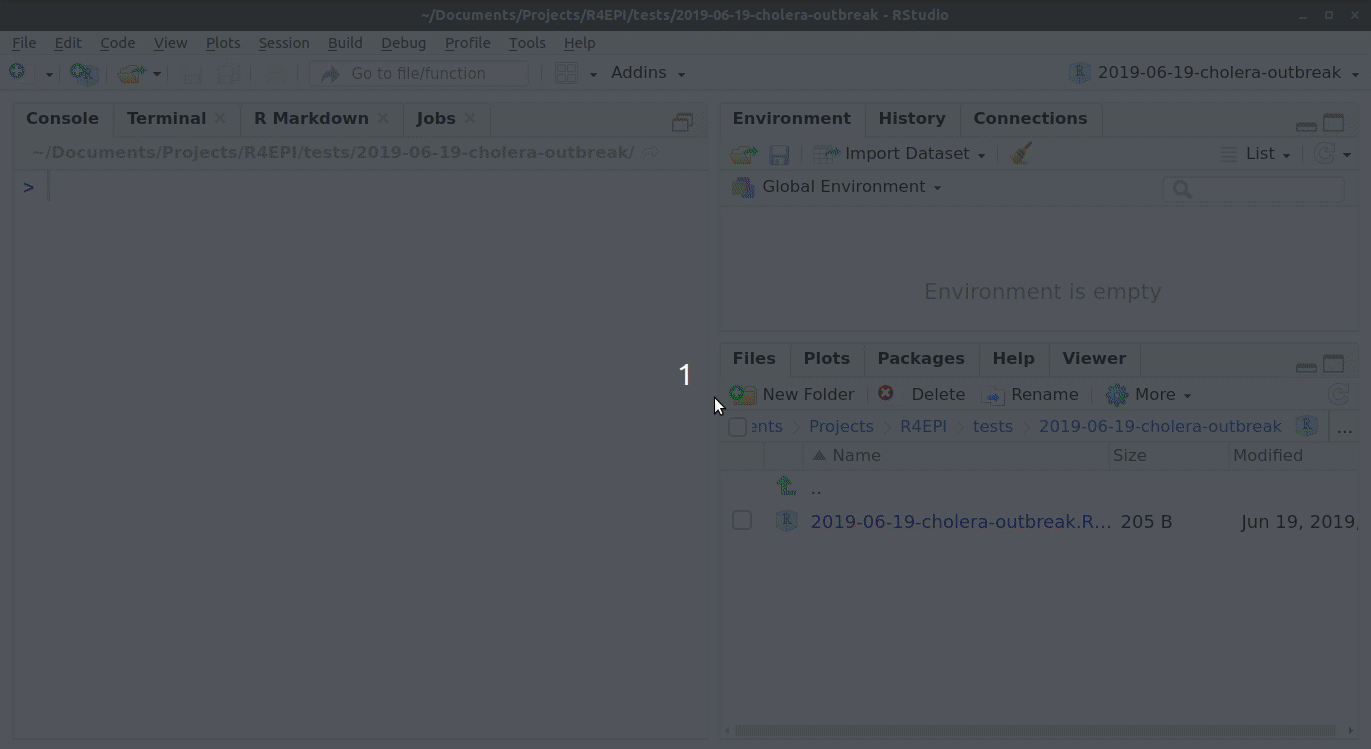Getting Started
This page describes important first steps for getting started with R, RStudio, and the templates!
A step-by-step walk-through of an outbreak template case study is available in the Training Materials pages of this website.
NECESSARY COMPONENTS
R
R is a free software for statistical computing and graphics. The templates need at least R version 3.3. We recommend downloading R directly from CRAN, a central repository of R code, packages, and documentation. If desired, the MRAN version of R will work as well.
Caveat if using MRAN: MRAN is a version of R that has modifications that are outside the scope of this project, however, it should be noted that it also locks the version of all packages to a specific date, so care is needed to specify repositories when installing R packages. If you are unsure whether you have MRAN or CRAN R installed then see this FAQ.
RStudio Desktop
RStudio is an interface for easier use of R, and enables production of automated reports. RStudio must be downloaded separately and in order for it to function you must also have R installed on the computer.
Please have RStudio version 1.1.463 or greater installed.
There is an overview of RStudio, including comparisons to Stata, in the Training Materials pages.
Configuring RStudio
It’s important to start R every time with a clean working session. To do this, you must ensure that RStudio is set up correctly. Go to Options > Global Options and do the following:
- de-select “Restore .RData into workspace at startup”. This ensures R never loads any previous workspaces
- Select “Never” from the dropdown menu for “Save workspace to .RData on exit”. This ensures that R will never attempt to save your workspace when you close it.
Your Global Options window should look like this:
When writing RMarkdown and code, it’s common to wrap your text at 80 characters. You can add a reference line for this in RStudio:
Setting the default R repository if using MRAN
If you are using Microsoft’s version of R (MRAN), the packages are all locked to one specific date (as of this writing, it’s 2018-08-07). If you are unsure whether you have MRAN or CRAN R installed then see this FAQ.
To install packages that were either created or updated after this date, you should use the RStudio cloud repository. The following code will update a file called .Rprofile that lives in your home directory (on Windows, this directory is usually “C:\Users\<username>“).
To create this file and set your default repository, open R and type:
## Install the use.this package and once done, you can comment the install.packages line out
install.packages("usethis", repos = "https://cran.rstudio.com/")
library("usethis")
edit_r_profile()
An editor window will open up and instructions will be printed to your R console. Paste the following code in the editor, save it, and restart your R session:
local({
r <- getOption("repos")
r["CRAN"] <- "https://cran.rstudio.com/"
r <- r[names(r) != "CRANextra"] # avoid a common error with MRAN installations
options(repos = r)
})
This sets the default repository to be https://cran.rstudio.com so that you will always have the latest version of R packages available.
Updating your R version
Please make sure you have the latest version of R installed. To do this you can use the installr package. See this page for details.
For MSF Field Epidemiologists, you do not have full admin rights to be able to do this on your field laptops. Please liaise with someone in your headquarters to ask what the best way is to do this.
install.packages("installr") # install package
installr::updateR() # updating R.
## If you wish it to go faster, run: installr::updateR(TRUE)
Installing the sitrep package
The sitrep package, developed by MSF and partners, is stored on the website GitHub. Therefore, the procedure to install these packages have one extra step required.
To install sitrep from GitHub you must first install the drat package.
install.packages("drat", repos = "https://cran.rstudio.com")
Once drat is installed, use its addRepo() function to add the “R4EPI” project to the list of valid repositories.
This command below will install the latest release of the sitrep package and also install any packages necessary for use of the templates that are not currently installed on your machine.
drat::addRepo("R4EPI")
install.packages("sitrep", dep = TRUE)
If you are getting errors, check the frequently asked questions.
Opening the templates
The outbreak and survey report templates are special scripts called “R-Markdowns”, and are included with sitrep package installation. You can open and modify them to create customized automated reports. Read more about RMarkdown scripts and how to modify the templates in Training Materials pages of this website.
To access the templates:
- Go into Rstudio
- Under the ‘File’ button (top left of your screen), click on the “+”
- Then click on “R markdown…”,
- and select “From template”; you should be able to see all the options of templates that are available. For example “Outbreak Report”.
If you are not seeing these, then please take a look at this GitHub post.
Folder structure
It is strongly advised that you save your RMarkdown template and any related data within the same folder - specifically within a R Project. Read more about working within R Projects in the R Basics section of the Training Materials pages.
NICE-TO-HAVE COMPONENTS
Tools for building packages
Most packages will have windows binaries available for installation. For those that don’t, the RTools suite is a straightforward, easy-to-install (with administrator priviledges) toolset that gives the user the ability to compile and install R packages directly from source on windows machines.


